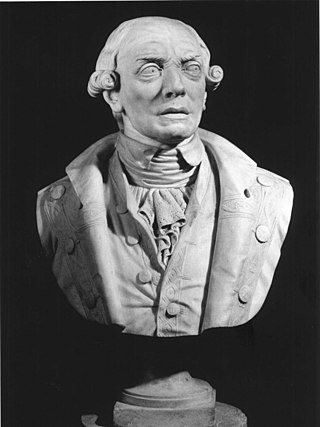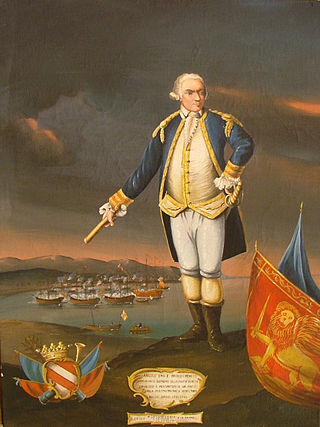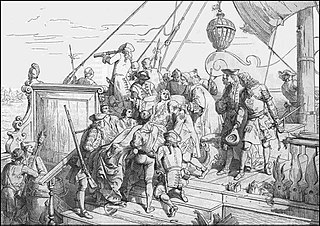
The Captain General of the Sea (Venetian : Capitano Generale da Mar) was the wartime commander-in-chief of the Venetian navy.

The Captain General of the Sea (Venetian : Capitano Generale da Mar) was the wartime commander-in-chief of the Venetian navy.
The post of Captain General of the Sea was filled only during wartime, by election by the Great Council of Venice, usually from one of the members of the Venetian patriciate with long experience in naval affairs, although occasionally younger or less militarily experienced men were selected. [1] During the later 17th century, the considerable expenses that the office entailed made the wealth of the candidates an important factor in their selection. [1]
Like all Venetian officials, the Captain General of the Sea was answerable to the councils composing the Venetian government (such as the Great Council or the Signoria) that set actual policy, but otherwise enjoyed comprehensive authority over all naval commanders and officials, as well as officials in the overseas colonies for matters pertaining to the fleet. [2] [3] When deciding on issues of strategy and tactics, however, he was constrained to obey the decisions of the war council, taken by majority vote. This was convened on the flagship and comprised all the commanding officers of squadrons (the Capi di Mare, signalled by the presence of a lantern on their vessels), the head of the commissariat, the commanders of any auxiliary or allied contingents, and, in case of landing operations, the commander of the troops carried on board the fleet. [4]
On campaign, the Captain General hoisted his ensign on a bastard galley, which served as the fleet flagship (the galera generalizia or Capitana). [3] Even after the other major European navies, the Venetian fleet, and even the Venetians' major naval rivals, the Ottoman Navy, began using mostly sail ships of the line during the 17th century, the tradition-minded Venetians insisted, despite heavy debate, to keep a galley as the Captain General's flagship. Only two exceptions to this are known, in 1617 and in 1715. [5] The crew of the flagship enjoyed special privileges, and was exempted from the usual deductions of pay for the coverings of the rowing benches. They also received free of charge a red coat, red breeches, and a red cap. [6] In combat the flagship took position in the centre of the Venetian formation. [1]
In case of the Captain General's death he was replaced either by the Provveditore Generale da Mar , or the most senior Capo da Mar, until such time as a new Captain General could be elected by the fleet. If for whatever reason that election was likely to be delayed, the Provveditore Generale da Mar was appointed as acting Captain General. [4]

The Action of 8 July 1716 was an indecisive naval battle that took place on 8 July 1716 during a Turkish attempt to capture the island of Corfu (Kerkyra), off the west coast of mainland Greece.

Angelo Emo was a Venetian noble, administrator, and admiral. He is notable for his reforms of the Venetian navy and his naval campaigns, being regarded as the last great admiral of the Venetian Republic.

Alvise Sebastiano Mocenigo (1662–1732), sometimes enumerated Alvise III Mocenigo, was the 112th Doge of Venice from 1722 to 1732. He was also Provveditore Generale (Governor) of Venetian Dalmatia twice.

The siege of Corfu took place on 8 July – 21 August 1716, when the Ottoman Empire besieged the city of Corfu, on the namesake island, then held by the Republic of Venice. The siege was part of the Seventh Ottoman–Venetian War, and, coming in the aftermath of the lightning conquest of the Morea by the Ottoman forces in the previous year, was a major success for Venice, representing its last major military success and allowing it to preserve its rule over the Ionian Islands.

The Venetian navy was the navy of the Venetian Republic which played an important role in the history of the republic and the Mediterranean world. It was the premier navy in the Mediterranean Sea for many centuries between the medieval and early modern periods, providing Venice with control and influence over trade and politics far in excess of the republic's size and population. It was one of the first navies to mount gunpowder weapons aboard ships, and through an organised system of naval dockyards, armouries and chandlers was able to continually keep ships at sea and rapidly replace losses. The Venetian Arsenal was one of the greatest concentrations of industrial capacity prior to the Industrial Revolution and responsible for the bulk of the republic's naval power.
Alvise Loredan was a Venetian nobleman of the Loredan family. At a young age he became a galley captain, and served with distinction as a military commander, with a long record of battles against the Ottomans, from the naval expeditions to aid Thessalonica, to the Crusade of Varna, and the opening stages of the Ottoman–Venetian War of 1463–1479, as well as the Wars in Lombardy against the Duchy of Milan. He also served in a number of high government positions, as provincial governor, savio del consiglio, and Procuratore de Supra of Saint Mark's Basilica.
The Captain of the Gulf was a senior naval command of the Republic of Venice.

The Provveditore Generale da Mar was the most senior peacetime office in the Venetian navy and in charge of governing the Venetian overseas empire.
A sopracomito was the captain of a galley in the Venetian navy. Elected from among those among the Venetian patriciate who already had some naval experience, the sopracomito was an important position and stepping-stone in the naval cursus honorum of the Republic of Venice. It entailed considerable responsibilities for crewing and maintaining a galley as well as great expenses, which made it increasingly the province of the wealthier patricians.
The governatore dei condannati was a senior commander of the navy of the Republic of Venice. The post initially headed the galley squadron manned by convicts and captives rather than free crewmen.
The Capitano delle Navi was a senior commander of the ships of the line of the navy of the Republic of Venice.

The Capitano Straordinario delle Navi was the senior wartime commander of the ships of the line of the navy of the Republic of Venice.
The Ottoman reconquest of the Morea took place in June–September 1715, during the Seventh Ottoman–Venetian War. The Ottoman army, under Grand Vizier Silahdar Damat Ali Pasha, aided by the fleet under Kapudan Pasha Canım Hoca Mehmed Pasha, conquered the Morea peninsula in southern Greece, which had been captured by the Republic of Venice in the 1680s, during the Sixth Ottoman–Venetian War. The Ottoman reconquest inaugurated the second period of Ottoman rule in the Morea, which ended with the outbreak of the Greek War of Independence in 1821.

Lodovico Flangini was a Venetian noble who served as Capitano Straordinario delle Navi during the Seventh Ottoman–Venetian War.

The Provveditore all'Armata or dell'Armata or d'Armata was a senior official and admiral of the Venetian navy. After the establishment of a sailing fleet next to the traditional galley fleet in the late 17th century, he was the most senior squadron admiral of the latter.
This is an alphabetical index of people, places, things, and concepts related to or originating from the Republic of Venice. Feel free to add more, and create missing pages.
Girolamo Zane was a Capitano generale da Mar of the Venetian fleet during the War of Cyprus.

Lazzaro Mocenigo was a Venetian nobleman who distinguished himself as an admiral during the Cretan War against the Ottoman Empire.
The Provveditori all'Armar were officials of the Republic of Venice responsible for the provisioning and equipment of the ships and crews of the Venetian navy.
The Patron delle Navi, also Patrono or Patrona delle Navi, was a squadron commander of the ships of the line of the navy of the Republic of Venice.